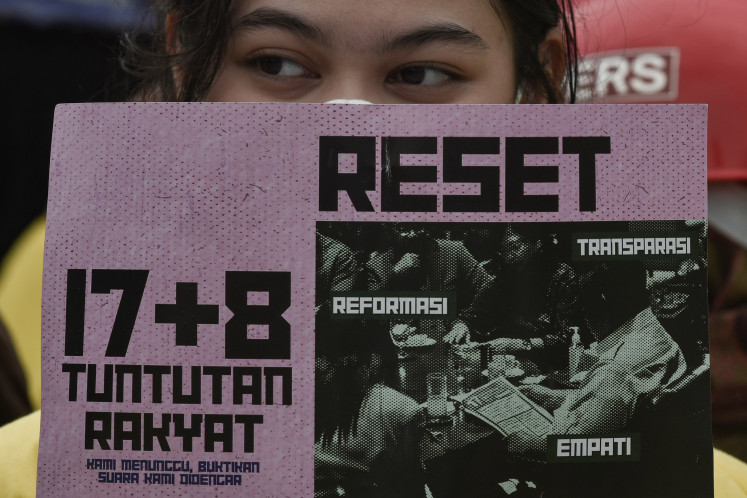Popular Reads
Top Results
Can't find what you're looking for?
View all search resultsPopular Reads
Top Results
Can't find what you're looking for?
View all search resultsDissecting performance with the causal microscope
Have you ever dreamt of an acid test to determine whether you should extend an offer to a high-flying applicant? At Bertelsmann AG, the global media corporation from Germany, personnel managers ask applicants to solve an apparently simple mini-case: Imagine that the performance of one team member is very poor
Change text size
Gift Premium Articles
to Anyone
Have you ever dreamt of an acid test to determine whether you should extend an offer to a high-flying applicant? At Bertelsmann AG, the global media corporation from Germany, personnel managers ask applicants to solve an apparently simple mini-case: Imagine that the performance of one team member is very poor. What would you do?
To solve such a problem, leaders must appreciate the "granularity of performance". Finding out what exactly drives success and failure through minute analysis forms the basis for effective action. Using what I call the "causal microscope", you can make five precise inquiries related to the different stages of the causal reasoning process. They will help you evaluate and upgrade the quality of explanations that you and others propose. Among other things, this tool is useful at all stages of the human resource management process, such as staffing, appraisal, rewarding, development and dismissal.
As an illustration, let us return to what I call the "Bertelsmann Acid Test". Asked how he would deal with a poorly performing team member, one promising job aspirant replied: "We are living in a free market economy, where everybody gets what he deserves. If the guy's performance is bad, he should be fired!" The following test battery reveals that the candidate did not address any of the critical issues.
1. Were both personal and situational factors considered in a balanced manner?
The applicant did not bother to analyze the causes of poor performance at all! He just reacted instinctively to the question posed by the interviewers. Possibly, his response was derived from a simple theory, that poor performance is always due to lack of motivation. Probably he automatically activated a heuristic precept to deal with such a situation. Maybe he always punishes those he deems unmotivated to deter others from emulating them and assumed that everybody else uses the same approach.
Apart from explaining the team member's failure through a range of personal factors such as unstable personality, incompetence or insufficient efforts, the candidate could have empathetically considered external circumstances. For instance, having been placed in a team, the individual mentioned in the acid test might have been tempted to try free-riding. Here is an example of a mitigating factor: When people have their first child, they often temporarily become more occupied with family matters.
2. How creative was the quest for an explanation?
A creative thinker engages in reverse thinking. The candidate could have argued that the performance problems were due to the team member's high motivation and then search for a logical explanation in the next stage of causal reasoning. As an example of reverse causation, unsatisfying results, through various intervening processes, might have weakened the team member's ability, so that he performed even more poorly. In each case, different remedies would be effective.
3. Was a compelling case made for the hypothesis?
The candidate could have demonstrated his capacity for systematic and dynamic reasoning to substantiate his hypothesis as follows: Due to strong intrinsic motivation, the team member constantly upgraded his competencies and succeeded in his job. As a consequence, he became very sought-after and felt an urge to dedicate more time to his work, while paying insufficient attention to his family. To compensate for the neglect, the workaholic occasionally pampered his children, which in the long-term led to serious domestic troubles. In turn, the lack of harmony at home might have negatively influenced his work and caused the poor performance. As regards the antidote, this analysis suggests that leaders have to strive for an optimal balance between work and leisure, giving employees more time for their families.
Here is an alternative explanation: A deterioration in results, possibly caused by strong competitive pressures, might have diminished the team member's motivation. Because of the disappointing outcome and motivational problems, the company's management may have lowered his ratings and invested less in his training. Consequently, his skills became obsolete, resulting in the underachievement.
With the causal microscope, you may detect the subtle effects of interaction within the team: The observed behavior of others may actually have been caused by your own actions! For example, the team member might have been sabotaged by his subordinates, which led to his poor performance. But the urge to undermine him could have been due to his previous public criticism of the employees in a culture where saving face is of paramount importance.
As a sanity check, it is important to examine whether the proposed explanations, with all of their refinement, do not run counter to common sense!
4. Was the choice of causal explanation based on powerful contrasts?
To settle on one explanation, which can incorporate several factors, the candidate should have analyzed the following: the team member's track record for the same type of assignment, his current performance in other projects and the comparative success of others who are carrying out the same duties. The applicant should also have considered enabling and constraining forces, which could have intensified the contrasts. For example, if the environment was unfavorable, the candidate might assign less responsibility to the person.
5. Were the results validated through different types of fact-searches?
The candidate did not bother to request further information or suggest experiments. He could have proposed assigning the team member to a different project and analyzed his success. Or it would have been possible for the applicant to invite him for tennis or golf to examine his target's search for performance explanations after the game.
Based on your interpretation of the answers to these five probing questions, you can profile candidates according to their preferred causal thinking styles. Ceteris paribus, you should hire those who are capable of identifying both personal and situational performance drivers. Besides, the gems are tough on themselves; they ascribe failure mainly to their own inadequacy and are eager to improve. They differ from those who consider themselves victims of "force majeure" - a category in which they often include their bosses and who resign themselves to their fate.
Even after getting an undifferentiated "cowboy answer" from a candidate, interviewers should not immediately reject him. They have to ask whether the situation biased his response. Maybe he reckoned that the panel would appreciate toughness. Thus, he might have given an answer that he assumed would please his interrogators but did not necessarily correspond with his true convictions. Should he fail this second test, too, he might still be hired if he possesses other outstanding qualities. Based on the diagnosis, he could be subsequently trained in the science of comprehensive and empathetic causal reasoning.
By discovering even subtle forces at work, you will be able to better evaluate yourself and others, and devise effective improvement strategies. Dissecting the granularity of performance by means of the causal microscope will empower you to pass even the "Bertelsmann Acid Test" with distinction!
Prof. Kai on Strategic Leadership, Column Number 5. Kai-Alexander Schlevogt (D.Phil. Oxford) is a professor of strategy and leadership at the National University of Singapore (NUS) Business School and author of The Art of Chinese Management (Oxford University Press). He can be reached at schlevogt@schlevogt.com










